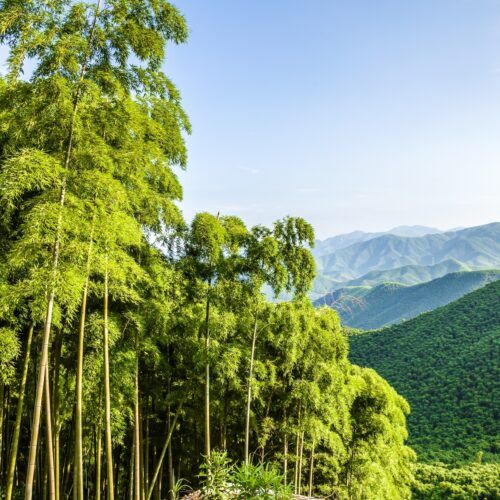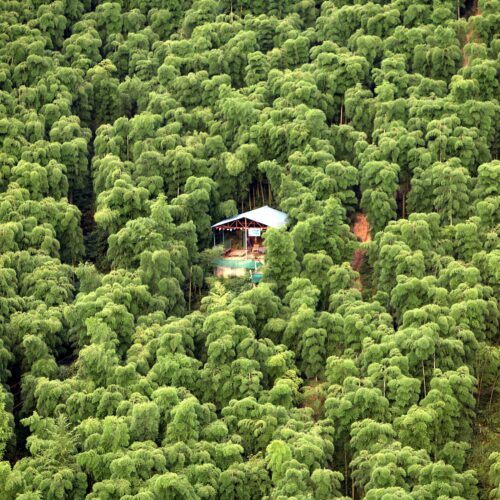Sustainable production of bamboo at MOSO®
A sustainable production of bamboo at MOSO is something that we are...
The production process of laminated bamboo includes all the steps to create a material that is a very stable and attractive natural alternative to many non-renewable materials. Laminated bamboo is produced from flat bamboo strips, which are horizontally or vertically placed and glued together into panels or beams as a base material for many applications. Below we explain how laminated bamboo flooring, beams and boards are produced from hollow bamboo stems, to reach the highest quality products:

Making use of the best base material will result in the best final product. Endless forests in Eastern-Chinese mountainous regions are covered with bamboo. Bamboo stems have an optimum age when talking about MOSO® Bamboo Products: ideally, the stems are harvested when they are 5 years old. Younger stems are not fully lignified and, therefore, the material will not have the right density and is not hard enough. Older stems turn grey, resulting in unattractive stains in final products. The quality of the bamboo stems can be partly determined during purchasing, but this is difficult to see in the new final product as the bamboo can still behave in an unexpected way later on when low quality stems have been used. MOSO® Bamboo Products are made of the best base material, which is checked by our own team, before production of laminated bamboo is started.
Freshly harvested bamboo stems are cut into strips, and this production process consists of more than just slicing the hollow bamboo stem into pieces. When removing the skin, bamboo material is also lost, which is considered waste that can be used as biomass for energy production. The more bamboo that is removed and turned into biomass, the more expensive the remaining strip becomes meaning the best bamboo strips have no skin left, thus are the most expensive strips. When determining the quality of the strips, it is the purchasing phase that is of importance, but you will not directly see the difference in the final product. MOSO® only accepts high quality strips for its bamboo products and MOSO® staff check the strips before production is started.
Laminated bamboo products come in two standard colours: Ecru and Caramel. Bamboo’s original, natural colour is light brown with a yellowish tint. By treating bamboo with steam, the light brown colour becomes more intense and the yellow shade disappears, we call this Ecru. By increasing the temperature and pressure during the steam treatment, they become darker and more brownish: Caramel. Ecru and Caramel strips are suitable for indoor use and, only after impregnation, Caramel strips are also suitable for outdoor use. The bamboo strips will be dried until they reach the necessary moisture percentage for further production.

Bamboo is, like any other natural material, affected by moisture: it expands when its moisture content increases and contracts when its moisture content decreases. It is crucial that the moisture content is lowered and controlled in drying rooms within each production step. The moisture content of the final product determines significantly the way bamboo products behave after installation. A large difference in moisture content can create big problems. As an example: when installing a product with a too high moisture content in a dry area, the bamboo product will shrink because the moisture content decreases in the new situation. To ensure the high quality of the final bamboo products, MOSO® quality inspectors keep track of the moisture content during and after production of each production batch.

Since bamboo is a natural product and only a steam process is used to change the colour of the strips, it is possible that there are slight differences in colour between the individual strips. Before the strips are ready to be processed further, they will be sorted by colour tone and checked for their quality. While many producers make bamboo products of the mixed coloured strips they have in stock, MOSO® can define the required colour or supply bamboo products in specific colour batches.

The bamboo strips will be glued together. Although the final product only contains 1 to 2% of glue, MOSO® aims to replace chemical resins by bio-glues. So far, no bio-glue can match the high MOSO® quality requirements. Until bio-glues can be used in production, without compromising quality, glue from respectable brands is used, ensuring the lowest emissions and best bonding. The type and amount of glue is very hard to determine once the final product is manufactured. Glue costs are significantly decisive on the total production costs. Many factories make their own glue or use glue from a local supplier to lower such costs, while MOSO® chooses to work with respectable brands like Dynea.

Depending on the type of product and required dimensions, the bamboo strips can be glued together in different ways. In the Plain Pressed variation, the bamboo strips are placed horizontally and in the Side Pressed variation, the bamboo strips are placed vertically. Each type of glue requires a certain temperature and compression to cure. Besides the quality of the glue, this curing process defines the quality of the end product. If the glue is not cured well, the bamboo can delaminate after a certain period of time.

The last step in production of laminated bamboo is the final profiling of the material. By using high quality, often European made machines, MOSO® ensures the right way of processing the material into flooring, panels or beams. All laminated bamboo products are checked one last time during packaging to ensure a flawless high-quality product. Laminated bamboo is, compared with wood, very steady in terms of stability and structure (no knots, no resins coming out). Laminated bamboo is a versatile product that can be used for a wide range of different applications.

Discover just a few of the many laminated bamboo products available at MOSO®

A sustainable production of bamboo at MOSO is something that we are...

Bamboo flooring has been gaining popularity for some years now, find out...

Discover everything about MOSO® Bamboo Products and why bamboo is the building...